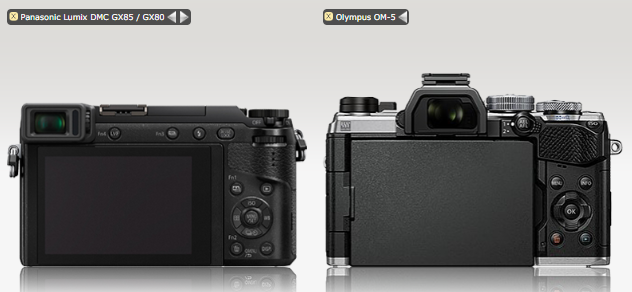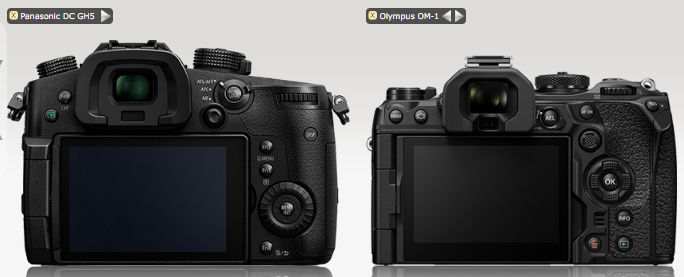
ac6000cw
Members-
Posts
640 -
Joined
-
Last visited
Content Type
Profiles
Forums
Articles
Everything posted by ac6000cw
-
I've got the Pana 12-32, 14-42 (non-pancake) and 14-42 PZ lenses, plus the Oly 14-42 EZ (power zoom) lens. No LX10 (or GX800 anymore), but my ZV-1 might be an interesting size comparison. I'll take some photos of the extended lenses on my GX80 with a ruler alongside. Note that of the pancake lenses, only the Oly has a focus ring, but it doesn't have any OIS - swings and roundabouts...
-
I agree - Sony will be doing image processing before the H.265 encoding (e.g. noise suppression, de-Bayering, sharpening etc.), whereas you might expect less of that happening with N-RAW - isn't it meant to be raw sensor data, warts and all? H.265 is a sophisticated codec, so I'm not that surprised 4:2:2 10-bit 8k video at 500Mbps from the A1 looks really good, especially on a static image like Andrew used in the N-RAW vs H.265 vs CDNG comparison article.
-
...which is why most non-enthusiast users would buy a decent phone and use it record video (the cost of an AX53 would pay for a pretty decent phone). The phone is very likely smaller than a camcorder and you definitely won't stand out in the crowd (even with a phone on a small gimbal). Camcorders have their niche, but it's been squeezed from both ends for years - at the lower end, phones and compact cameras getting decent video, MILCs at the other end. The AX700 has a modern 1" stacked BSI sensor with PDAF, but it's 116×89.5×196.5mm (W x H x L) and about 1 Kg. The small sensor AX53 is 73x80.5x161mm and about 600g. They're not especially small and light.
-
It's because if you have larger sensor the optics get larger as well - the sensor in the AX53 is 1/2.5" size - this is very small and allows an internal 20x zoom to be fitted inside a small (but not tiny) body. Put in a 1" sensor (which is about 4x the sensor area) with an internal x20 zoom lens and the body would get much larger and heavier. The next level up in the Sony range is the AX700 with a 1" sensor but only a x12 zoom - it's around 2x the weight and 2.5x the price. That takes it into the price area of a good MILC with a superzoom lens e.g, the A6700 with 18-135mm lens bundle is about the same price as the AX700, but has an APS-C sensor with 4x the area of a 1" sensor, weighs less and can record 10-bit 4:2:2 4k60p & 4k120p video.
-
I doubt it - for example, AFAIK including MPEG/AVC/HEVC in a product requires license fees to be paid to the patent holders (normally via a patent pool licensing organization). As end users we don't usually see those fees directly, because they are paid by the companies selling the products i.e. the fees are included in the purchase price.
-
intoPIX and Fraunhofer IIS are the two major contributors to the JPEG XS patent pool - https://www.jpegxspool.com/ and https://www.jpegxspool.com/s/JPEG-XS-Patent-Pool-Licensed-Patents-01-Oct-2023.pdf and https://www.tinynews.be/jpeg-xs-intopix-belgique/ As JPEG XS uses a wavelet transform, there is a reasonable chance TicoRAW uses a wavelet transform in its implementation, especially as JPEG XS has built-in support for RAW Bayer/CFA images - https://en.wikipedia.org/wiki/JPEG_XS#Sensor_compression But as intoPIX is a developer of video compression technology, TicoRAW unlikely to be "just another branded version of something that someone else wrote."
-
Yes, their raw image sensor data compression system. Do you know what intoPIX actually use inside the TicoRAW implementation? Discrete cosine transform (DCT) isn't a compression algorithm, it's just a mathematical transform (of a block of pixels into spatial frequency coefficients) that's particularly useful for 'natural image' compression systems. It doesn't compress the data (in fact it increases it, as the output coefficients are usually higher bit depth to maintain precision), just transforms it into a different representation. That makes it much easier to discard/downgrade the coefficient data afterwards while minimising the impact on image quality - how clever you are at doing that (and the subsequent lossless data compression) is basically what determines the compression efficiency (data reduction versus perceived quality) of the image compressor. DCT is far from being the only game in town though - there are other front-end transforms in use as part of image compression systems. But I agree it's very popular (for very good reasons) in natural image compressors.
-
I think it's because Z-mount has the shortest flange to sensor distance of the common mirrorless mounts. So it's possible to make a (2mm thick!) E-mount to Z-mount adaptor e.g. the Megadap one, but not the other way round.
-
It's TicoRAW from IntoPIX - see https://www.dpreview.com/news/9624409613/nikon-is-licensing-intopix-s-ticoraw-technology-for-its-z9-camera-system and https://www.intopix.com/tico-raw
-
I think he was talking about N-RAW versus h265. The bitrates for N-RAW are here - https://onlinemanual.nikonimglib.com/z9/en/06_video_recording_02.html#id226OJ0Y0V5Z - 4.1k at 24 p is 350 Mb/s in Normal quality mode.
-
Capital M = 'mega' = x1000000 Lowercase m = 'milli' = /1000 So megabits per second = Mb/s.
-
Maybe they should introduce Z-mount versions of their (low-end, for RED) RF-mount Komodo cameras, branded 'Nikon RED', 'Z-RED' or 'RED-Z', with maybe switchable color science compatible with either Nikon hybrids like the Z8/Z9 or other RED cameras. That might provide upward and downward paths between RED and Nikon cameras without diluting the RED brand.
-
The Chris & Jordan Peta Pixel review is a bit mixed (especially for video) - poor battery life, some IBIS jerkiness and of course high rolling shutter...
-
I agree - the RED cinema cameras will keep the RED branding - it would be silly to dilute/erase the RED brand image. (pure speculation) From a branding point of view, maybe Nikon might add some subsidiary RED branding to few video-orientated hybids e.g. 'RED Cinema' or 'Video by RED', in the way Panasonic and Sony use the Leica and Zeiss branding on some products?
-
The SL3 is released - https://www.dpreview.com/reviews/leica-sl3-initial-review From the review:
-
IIRC, that included RED being able to use the Canon RF-mount on their cameras - so I guess in theory a Nikon-branded RED camera could have a Canon lens mount on it... but the Canon-RED agreement might not allow that if RED were taken over by another camera company. So are we going to see some Nikon Z-mount cinema/video lenses eventually to go with a RED-designed camera, or is this takeover primarily about REDs IP/patents and high-end video processing knowledge?
-
Those are exactly the issues I have with the FP or FP-L - I like the small form-factor, but a camera without IBIS for video is basically ruled out for me, as I film almost 100% hand-held (and stabilizing in post is sometimes very difficult with the subjects I film, as well as being time-consuming).
-
I've also thought about trying/buying an A6700 a few times for the same reasons... pity it doesn't have a higher-res viewfinder than 2.36M-dot (having a 5.76M-dot EVF in the OM-1 is really nice, as is the 1.62M-dot rear screen)
-
Just added a graded, 8-bit Rec709 version of some of the clips to the folder - 'OMLog400 test graded 8-bit Rec709.mov'
-
Just added a graded, 8-bit Rec709 version of some of the clips to the folder - 'OMLog400 test graded 8-bit Rec709.mov'
-
Here is a collection of 10-bit OMLog400 and HLG files (and a couple of stills) from my OM-1 - https://drive.google.com/drive/folders/1527WMHFXJmDvTGI74QINJQdstgJPhXyt?usp=sharing All are FHD, using shutter priority ay 1/100s (auto-ISO and auto-aperture), auto WB (with the 'keep warm colors' option on) and C-AF set to a medium central area - so pretty much 'point and shoot' video. Lens was Oly 12-40 F2.8 pro. IBIS was sensor shift only, mostly on the maximum stability '+1' setting (which can cause jerky pans - the standard setting is '0').
-
For anyone interested, here is a collection of 10-bit OMLog400 and HLG files (and a couple of stills) from my OM-1 - https://drive.google.com/drive/folders/1527WMHFXJmDvTGI74QINJQdstgJPhXyt?usp=sharing All are FHD, using shutter priority ay 1/100s (auto-ISO and auto-aperture), auto WB (with the 'keep warm colors' option on) and C-AF set to a medium central area - so pretty much 'point and shoot' video. Lens was Oly 12-40 F2.8 pro. IBIS was sensor shift only, mostly on the maximum stability '+1' setting.
-
This is a good technical review (with some downloadable video samples) of the video side of the OM-1 - https://www.optyczne.pl/59.1-Inne_testy-OM_System_OM-1_-_test_trybu_filmowego_Wstęp.html
-
To add to what John has said, currently the best small (ish) Olympus/OM System camera is the OM-5 - that's basically the guts of an E-M1 iii in a smaller/lighter body (about the size of the GX85 if you ignore the viewfinder hump). I don't own one, but do own the E-M1 iii, so based on that: 8-bit video only, FHD is soft, UHD is OK, C4K is very good but is 24p only, video C-AF is good (uses PDAF), IBIS is excellent. The OM-1 is larger and rather more expensive, but smaller and lighter than the GH5. 10-bit 4:2:0 video is H265 Rec2020 in HLG and OMLog400 only, 8-bit video is H264 Rec709 in Flat, OMLog400 and any of the 'photo' profiles. 10-bit video modes are more detailed/higher resolution than equivalent 8-bit video modes - so for best quality go for 10-bit UHD/C4K in 24p/25p/30p (UHD/C4K 50p/60p is a bit softer, 10-bit FHD is rather better than 8-bit on E-M1 iii/OM-5). So far I've been quite pleased with the usable dynamic range on the OM-1 in 10-bit HLG and OMLog400 - the new sensor and 10-bit processing path is definitively a significant upgrade from the older E-M1 iii.
-
I bought a used OM-1 a while ago, and it's slowly turned into my favoured camera for video since then (despite some of its annoyances). I think part of the reason for that is because it has a very fast readout stacked sensor, with rolling shutter time around 5-7 ms in FHD & UHD, which seems to give a 'solidity' to the video combined with fluid motion handling (I normally shoot at 50p), compared to my G9 with about 12-15 ms rolling shutter. If my liking of the OM-1 video is due to low rolling shutter then maybe I'm subconsciously sensitive to the picture distortions created by rolling shutter (including interactions with the IBIS behaviour). But then I'm often filming subjects like trains which readily show up rolling shutter distortions, so maybe that's sensitised me to it?




